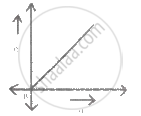Advertisements
Advertisements
प्रश्न
Obtain the equation for resultant intensity due to interference of light.
उत्तर
- The phenomenon of addition or superposition of two light waves which produces increase in intensity at some points and a decrease in intensity at some other points is called interference of light.
- Let us consider two light waves from the two sources S1 and S2 meeting at a point P as shown
- The wave from S1 at an instant t and P is, y1 = a1 sin ωt
The wave from S2 an instant t at P is
y2 = a2 sin(ωt + Φ)
Superposition principle - The two waves have different amplitudes a1 and a2, same angular frequency ω’ and a phase difference of Φ between them. The resultant displacement will be given by.
y = y1 + y2 = a1 sin ωt + a1 sin2 (ωt + Φ) y = A sin (ωt + Φ)
Where, A = `sqrt("a"_1^2 + "a"_2^2 + 2"a"_1"a"_2 cos phi)` .....(1)
`theta = tan^-1 ("a"_2 sin phi)/("a"_1 + "a"_2 cos phi)` ......(2) - The resultant amplitude is maximum.
Amax = `sqrt(("a"_1 + "a"_2)^2)`;
when Φ = 0, ±2π, ± 4π …….(3) - The resultant amplitude is minimum.
Amin = `sqrt(("a"_1 - "a"_2)^2)`;
when Φ = 0, ±π, ± 3π ± 5π …..(4) - The intensity of light is proportional to the square of amplitude.
- I α A2 ……(5)
Now equation (1) becomes
I α I1 + I2 + 2`sqrt("I"_1"I"_2)` cos Φ .(6) - 9. If the phase difference, Φ = 0, ± 2π, ± 4π., it corresponds to the condition for maximum intensity of light called as constructive interference.
- The resultant maximum intensity is,
Imax α (a1 + a2)2 …….(7) - If the phase difference, Φ = + π, ± 3π, ± 5π …., it corresponds to the condition for the minimum intensity of light called destructive interference.
- The resultant minimum intensity is Imin α
(a1 – a2)2 α I1 + I2 – 2`sqrt("I"_1"I"_2)` ......(8)
As a special case, if a1 = a2 = a, then equation (1) becomes,
A = `sqrt(2"a"^2 + 2"a"^2 cos phi)`
= `sqrt(2"a"^2 (1 + cos phi))`
= `sqrt(2"a"^2 2cos^2 (phi//2))` -
A = 2 a cos(Φ/2) ….(9)
I α 4a2 cos2 (Φ/2) [∴ I α A2] ……(10)
I α 4 I0 cos2 (Φ/ 2) [ΦI0 α a2] …….(11)
IMax = 4I0 when, Φ = o, ± 2π, 4π …..(12)
Imin = 0 when, Φ = ± π, ± 3π, ± 5π …..(13)
Conclusion:
The phase difference between the two waves decides the intensity of light meet at a point.
APPEARS IN
संबंधित प्रश्न
Write the necessary conditions to obtain sustained interference fringes.
How does the angular separation between fringes in single-slit diffraction experiment change when the distance of separation between the slit screens is doubled?
Why are multiple colours observed over a thin film of oil floating on water? Explain with the help of a diagram.
What are the two methods for obtaining coherent sources in the laboratory?
What are coherent sources of light?
Explain constructive and destructive interference with the help of a diagram?
Discuss the interference in thin films and obtain the equations for constructive and destructive interference for transmitted and reflected light.
The ratio of maximum and minimum intensities in an interference pattern is 36 : 1. What is the ratio of the amplitudes of the two interfering waves?
Light of wavelength 600 nm that falls on a pair of slits producing interference pattern on a screen in which the bright fringes are separated by 7.2 mm. What must be the wavelength of another light which produces bright fringes separated by 8.1 mm with the same apparatus?
On a rainy day, a small oil film on water shows brilliant colours. This is due to ____________.
In Young's experiment, the distance between the slits is doubled and the distance between the slit and screen is reduced to half, then the fringe width ____________.
In Young's double slit experiment with a source of light of wavelength 5860 Å, the first maxima will occur when ____________.
The phenomenon of interference is based on ______.
In interference experiment, intensity at a point is `(1/4)^"th"` of the maximum intensity. The angular position of this point is at (sin30° = cos60° = 0.5, `lambda` = wavelength of light, d = slit width) ____________.
The graph shows the variation of fringe width (β) versus distance of the screen from the plane of the slits (D) in Young's double-slit experiment Keeping other parameters the same. The wavelength of light used can be calculated as d = distance between the slits ______

Light waves from two coherent sources arrive at two points on a screen with a path difference of zero and λ/2. The ratio of the intensities at the points is ______
In Young's double-slit experiment, if the two sources of light are very wide, then ______.
If we have two coherent sources S1 and S2 vibrating in phase, then for an arbitrary point P constructive interference is observed whenever the path difference is ______.
Interference fringes are produced on a screen by using two light sources of intensities I and 9I. The phase difference between the beams is `pi/2` at point P and π at point Q on the screen. The difference between the resultant intensities at point P and Q is ______.
Two coherent sources P and Q produce interference at point A on the screen where there is a dark band which is formed between 4th bright band and 5th bright band. Wavelength of light used is 6000 Å. The path difference between PA and QA is ______.
